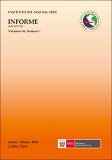Por favor, use este identificador para citar o enlazar este ítem:
https://hdl.handle.net/20.500.12958/3333| Título : | Línea base del sitio piloto Isla Lobos de Tierra: Recursos pesqueros |
| Otros títulos : | Baseline survey of the Lobos de Tierra island Pilot site: Fisheries resources |
| Autor : | Flores Castillo, Daniel Sarmiento Bendezú, Héctor Galán Galán, Julio Tejada Cáceres, Alex |
| Palabras clave : | Recursos bentónicos;Línea base;Isla Lobos de Tierra |
| Fecha de publicación : | 2019 |
| Editorial : | Instituto del Mar del Perú |
| Citación : | Inf Inst Mar Perú 46(1), 2019, p. 60-66 |
| Citación : | Informe IMARPE;46(1), 2019 |
| Resumen : | El área de estudio comprendió los límites geográficos establecidos para la
Reserva Nacional Sistema de Islas, Islotes y Puntas Guaneras (RNSIIPG) – Isla Lobos de Tierra. Entre el 25
de febrero y 4 de marzo 2014 se realizó el Estudio de Línea Base (ELBA) en este Sitio Piloto como parte del
Proyecto GEF PNUD Humboldt, a fin de establecer la distribución y abundancia relativa de los principales
recursos bentónicos comerciales. Del 12 al 20 de marzo 2015 se monitorearon estaciones seleccionadas del
ELBA. Se recolectaron los organismos que estuvieron contenidos en la unidad de muestreo (1 m2), tanto en
el submareal somero como en la zona intermareal. En el ELBA 2014 se recolectaron y analizaron 23 recursos
de importancia comercial, de los cuales 8 correspondieron a peces, 12 a moluscos, 1 a equinodermos y 2 a
crustáceos; destacaron concha de abanico Argopecten purpuratus, chitón Acanthopleura echinata, caracol chino
Crossata ventricosa y palabrita Transennella pannosa. En el monitoreo 2015, la recolección de recursos bentónicos
fue limitada debido a una floración algal intensa que disminuyó la visibilidad de los buzos. Se identificaron
20 recursos de importancia comercial, de los cuales 13 fueron moluscos, 2 equinodermos, 2 crustáceos, 2
peces y 1 macroalga. En el ELBA se determinó que los recursos bentónicos fueron más abundantes en la zona
protegida y en el extremo norte de la zona expuesta de la isla; mientras que, en el monitoreo las densidades
fueron menores, pero mostraron la misma distribución. ABSTRACT: The study area included the geographic limits established for the National Reserve System of Guano Islands, Islets and Tips (RNSIIPG in Spanish) - Isla Lobos de Tierra. Between February 25 and March 4, 2014, the Baseline Survey was conducted at this Pilot Site as part of the UNDP/GEF Humboldt Project, in order to establish the distribution and relative abundance of the main benthic resources. From 12 to 20 March 2015, selected Baseline Survey stations were monitored. The organisms that were contained in the sampling unit (1 m2) were collected, both in the shallow subtidal and in the intertidal zones. In the 2014 Baseline Survey, 23 commercially important benthic resources were collected and analyzed, including 8 fish, 12 mollusks, 1 echinoderm, and 2 crustaceans. The most important species were Argopecten purpuratus, Acanthopleura echinata, Crossata ventricosa and Transennella pannosa. In the 2015 monitoring, the collection of benthic resources was limited due to an intense algal bloom that decreased the visibility of divers. We identified 20 commercially important benthic resources, which included 13 mollusks, 2 echinoderms, 2 crustaceans, 2 fish and 1 macroalga. The Baseline Survey found that benthic resources were more abundant in the protected area and at the northern end of the island’s exposed zone, while in monitoring, densities were lower, but showed the same distribution. |
| URI : | https://hdl.handle.net/20.500.12958/3333 |
| ISBN : | 0378-7702 |
| Aparece en las colecciones: | Informe vol. 46(1) 2019 |
Ficheros en este ítem:
| Fichero | Descripción | Tamaño | Formato | |
|---|---|---|---|---|
| Informe 46-1 Línea base del sitio piloto Isla Lobos de Tierra.pdf | 1,4 MB | Adobe PDF |  Visualizar/Abrir |
Este ítem está sujeto a una licencia Creative Commons Licencia Creative Commons

